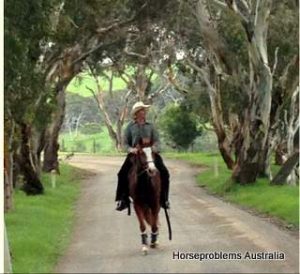We have all seen the horse that won’t walk whilst out on the trail ride or pleasure riding as we call it. Highly frustrating and usually ends up with the horse doing Piaffe and the rider being Pi-offed. Here’s why it happens and here’s how to fix it.
THE CAUSE
The material following hereafter relates to the horse at the walk, not at the trot or canter. A rider may ride on the bit or off at those two gaits. It does not matter. What does matter is how the rider rides the horse at the WALK. To be relaxed, a horse must be able to lower its neck and just “mosy along”. It cannot lower its neck if you are sitting there with a contact, as to do that it actually needs a longer rein because the neck must be allowed to stretch out further. Tense horses have their heads and necks up, relaxed ones lower the front end.
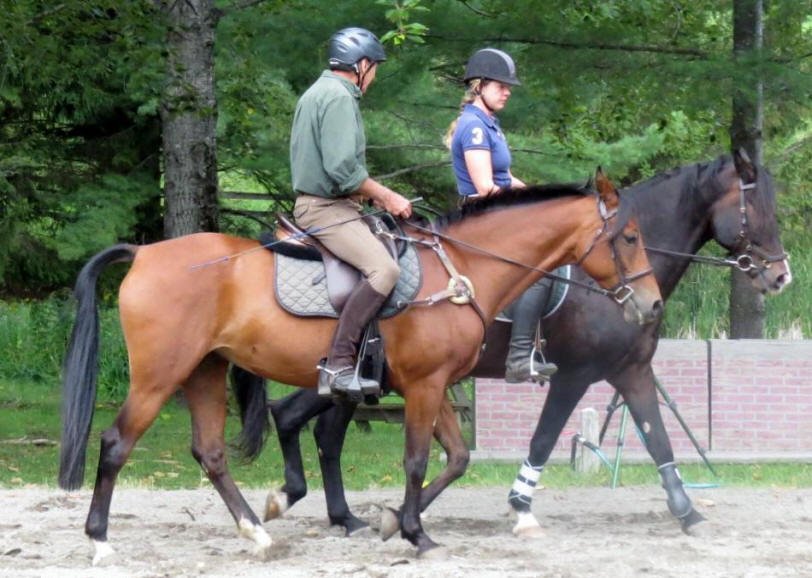
A majority of people like to keep a contact on their horse’s mouth when on a trail ride. These are almost always the people who end up with jig jogging horses. They do so because they think that if they do not the horse will bolt off. I also think that it gives them a comfort zone, particularly those people who were taught to ride in the ‘English’ way of going. In fact, all horses and especially young or freshly broken in horses should be walked everywhere on a loopy rein and only be “On the Bit and Round” when doing flat work. This will keep the horse seine and much more accepting of the hard boring grind of the circle work that flat work includes. A horse cannot see the rhyme nor reason in going endlessly around an arena because in the horse’s mind there is no beginning or end. Nothing to focus on, no completion, no arrival. This is where you will always get your misbehavior, tension, stress and un-happiness.
NORMAL PEOPLE
They hold onto the reins and pull on a horses mouth “IN CASE THE HORSE JOGS” and if it does, they hold on tighter and tighter until the horse not only jogs but also runs sideways, canters on the spot, caprioles and then even rears. The horse is locked in a box and has no where to go, so it chooses one of the available escapes.
NATURAL HORSEMEN
They refuse to hang onto the reins and if the horse breaks gait from the walk they punish the horse by sending it precisely in the opposite direction that it wants to go and then say, “I dare you to do it again” In other words, throw the rein contact away totally and be on a “Pleasure Rein”. That means having no feel of a contact with the horse’s mouth at all, in fact, a slight loop in both reins. This is not only what a pleasure rein should mean to a rider but it certainly must be to a horse. If you are going for a pleasure ride, shouldn’t your horse be rewarded with the same relaxing feeling, in return for all of its good work on the training ménage?
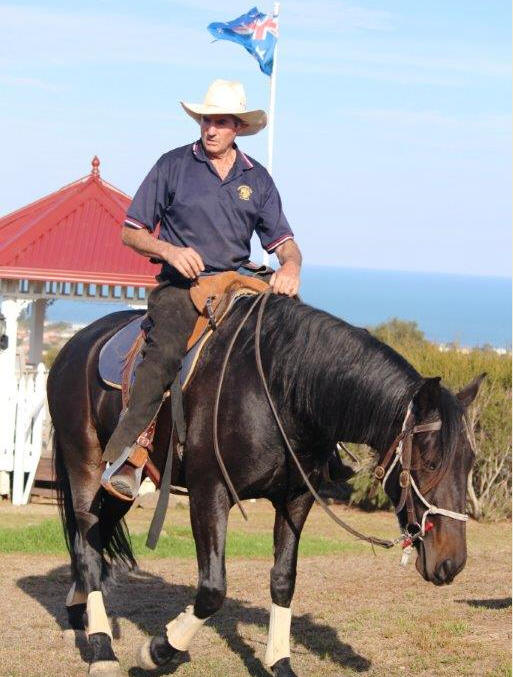
Psychological discipline is always the way to go with horses. Instead of Pi-ing us off, we watch them getting pioffed and we remain relaxed. The opposite of what the horse is aiming for.
Trying to ride a horse out on a pleasure ride whilst having a contact on its mouth causes the fight that causes the jig jogging.
-
- You pull on the horse’s mouth it pulls back.
-
- Force meets force.
-
- You give them something to fight with.
-
- You are adopting the riding style that normal people do, not the way “Natural Horseman” do.
Here’s how to ride the pleasure ride and why.
THE WALK
When on a pleasure ride and in fact anytime you are riding, asking your horse except in competition when you may be required to be on the bit, walk on a loose rein. That means loose as a goose or so that you have no contact with your horse’s mouth.
People who go along with the good old contact are causing the fight the horse wants. No contact means no fight.
These riders are holding onto the horse’s mouth “IN CASE” the horse jogs off or breaks stride into the trot. WRONG THINKING. This is precisely what the horse wants you to do. Suck you into a fight and manipulate you into frustration in the process.
We should always be thinking along the lines that if our horse is naughty, it is the one that should receive the frustration not us. We should just sit there thinking things like, “Go on, do it again.”
One should ride on what I call, “a pleasure rein” That means, the reins long enough that you do not have contact on the horses mouth but not so long that you do not have control if you suddenly need it. Not Western length reins. This means learning where your rein hand should be to achieve that.
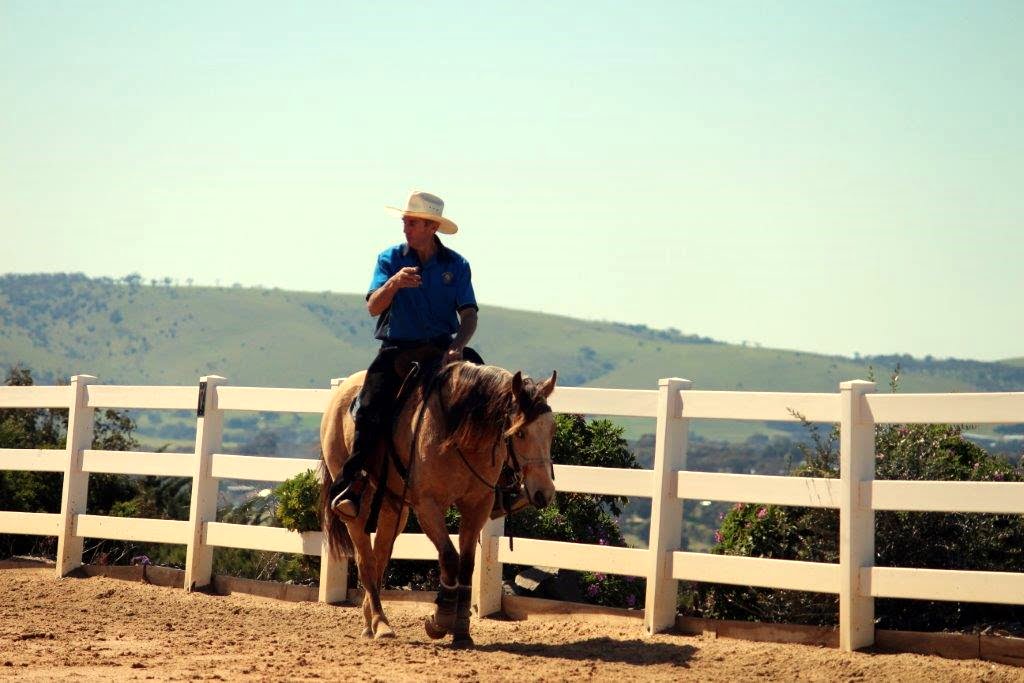
I can hear most people thinking that just a little light contact will be OK. Well it won’t. Any contact, light or strong, will give the horse the excuse to want to jog off. The other thing about a little contact against a lot and at least having the horse round if you so wish, is that you are continually building the upside down neck and the wrong muscle configuration on the horse, not to mention ignorance of every type one likes to think about.
There is an exception to the rule however. Whenever you see imminent danger ahead, traffic, a narrow opening or something that the horse doesn’t want to go over or through, collect your reins up briefly so as to have the lateral control to keep the horse focused on the direction you want to travel and then immediately drop the reins again back to the “Pleasure Rein” Even though you briefly shortened your reins, it doesn’t mean that you necessarily have a full contact on the horses mouth. After all, you want the horse to go forward and to confront its fears, so give you hands but have the reins short enough that you can instantly steer from a lateral point of view, in order to keep the horse looking at or into, where you want it to go.
-
- Ride your horse down the road on a pleasure rein. The horse may break into a jog. YOU MUST ALLOW IT TO!!!!
-
- If it does, within one step, halt it as strongly as you need to. Then back it up two or three steps and instantly throw your reins away to the pleasure rein and no contact on the mouth. Dare the horse to do it again. When it does, repeat the procedure.
With young horses that I break in, I teach them this on the very first day that they try it and that is basically the end of it from that day on. Maybe a reminder now and again if they get a rush of blood. With the older horse that has learnt the habits and needs Re-educating, you may have to repeat the procedure hundreds of times or only a dozen times. They are all different. Stay cool and relaxed. Never tense. Tense Trainers cannot train Horses!
CO-OPERATION FROM YOUR FRIENDS.
If you ride out with friends and you are trying to re-educate your horse not to jig-jog, you will not succeed unless you train your friends as well. This is because, every time you stop and back your horse up, your friends must immediately halt otherwise the training opportunity has been lost and your horse will get even more frustrated because you cannot train a horses mind while it’s mates are walking away and leaving it behind. Well a pro may be able to but you won’t. You and your horse will need everything in your favor.
ORGANIZED RIDES
Organized Trail Rides like Pony Club Rally in the Forrest for instance, are a recipe for disaster when anti training of such Horses is concerned. For no-one cares what your Horse is doing and all manner of things go on that compound the excitability of your Horse and the frustration of yourself. Kids ‘hooning’ past from behind and so on. If you have a Horse that has the propensity to be a candidate for jogging, don’t go. Train with your Friends and at Home. YOU CANNOT TRAIN at Pony Club or Endurance Rides.
Here is another system that works.
THE DIMINISHED CIRCLE
Another system that I have had success with is the use of the one rein diminished circle.
You ride down the road and your horse jogs off. You immediately take a direct rein and circle the horse on a small 5 metre or smaller, circle. Direct the horse with the inside rein only and do not pull on the outside rein otherwise you are up to your same old tricks of fighting with the horse’s mouth with two reins. You cannot win. Eventually, the horse will slow to a walk because it is going nowhere and not achieving its aim of ever increasing its speed and promoting a fight with your two rein hands.
The absolute moment the horse makes its transition downward to the walk, point it in the original direction of travel that you were taking in the first place. Do not pick the reins up. If it jogs, circle again and repeat the procedure until such time it gets the message that whilst ever it is jogging it will be going no-where and only when it walks will it get to its goal, home.
BOTH SYSTEMS MAKE HORSES WALK FASTER
When you beat a horse as its own game as we say, you find that they always start to walk faster and with bigger steps than they ever have. This is a sign that you have won and that they have decided that there is no use fighting. Therefore, “I will walk faster than I ever have, so as to get home as quick as possible considering that I am not allowed to jog anymore.” DON’T EVER RESTRAIN THE WALK!! Don’t touch the reins of a power walking horse. Appreciate the training of a better Dressage walk.
TROTTING UP NOT JIGGING
Even if Horses don’t fit the description of jogging because of tenseness, a mouth gripping Rider or excitability, they can be triggered simply because they cannot keep up with Horses with better walks. They may be smaller, shorter legs, shorter strides and so on and if the Owner isn’t reading the Horse and thinking about situations (defensive riding) the Horse can be turned into a ‘jogger’.
When one identifies this potential, they should regularly trot up and catch up, making the Horse do the upward transition which makes it ok and stops jogging.
There is a vast difference between the ‘jigging’ horse that is trying to catch up but being restrained to the trotted up Horse that isn’t being restrained. I rode exactly one of these last week and fixed it.
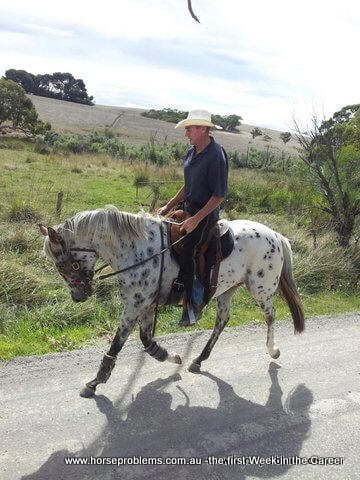
If you avail yourself of the opportunity of trotting the Horse to catch up, on a pleasure rein and adding ‘stop to seat’ as you reach the front Horse each time, you will find that within no time, your Horse will start to anticipate regular trot ups and back to walk, at a set point of being left behind. Say 10 metres. You will notice that after a while, your Horse will start to jog up at it’s own set point, something that I do allow but only after the system is imprinted well and Horse has totally mellowed. Then, they will even trot up at the very set time and do the downward transition as well, all with no reins at all. This is a great trick to teach the best downward transitions to seat, as I did last week. That transferred into flat work the very next day and was most noticeable.
Whilst ion the subject of ‘set points’, that happens to be the point in time being one second before the Horse actually goes to jog off and so that you make it your command rather than a none sanctioned jogging. There is a vast difference. To miss the timing of this is to fail at the remedial training of the problem.
The jog comes with a high frame and ‘on the Bit’ as the Rider vainly tries to restrain the Horse. The steps are choppy and ‘passagy’ whereas the trot up, done on a pleasure rein comes with a lowering of the neck in a more Western form and with relaxed strides that are therefore much bigger.
However, before going to the trot up, on Horses that have never been first taught that ‘jogging’ is not on, first show them the error of their ways by following the back up system with the co-operation of your Friends. That will then allow the Horse to appreciate the difference between attempted jogging up and a command of trot up. It will therefore appreciate the latter and co-operate with it.
LOOKING AROUND
I often get asked about Horses that continually want to ‘star gaze’ and look around. I say, “so what” it is a ‘pleasure ride’ so why shouldn’t the Horse be allowed to look precisely where it wants? To continually adjust it for those reasons is to have ‘paralysis of the analysis’ and make yourself a pain to the Horse, asking for trouble that you don’t want.
ADJUSTING THE COURSE
Again, I bother little about this as long as we are going roughly in the direction that I want to go but to get absolutely pedantic is again, to stress the Horse and ask for perhaps ‘jig jogging’
REMEMBER
-
- Never blame the horse or equipment.
-
- Never go and reach for a bigger bit.
-
- Don’t think gimmicks will help-they won’t.
Get professional help if required. (On a subject such as this, choose a Western Rider.)
Your horse will love you more!!
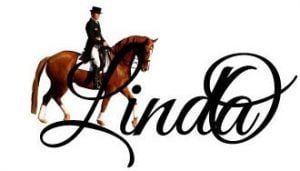
Listen to Your Horses

